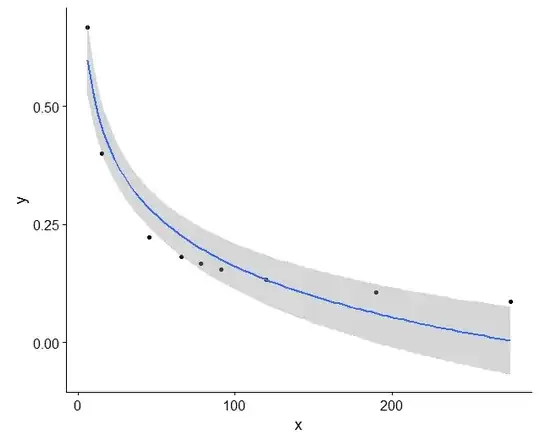What I originally saw in the data (and originally wrote some hours ago) --
There are two obvious things by just looking at the numbers:
Note that $2x$ is of the form $k(k+1)$.
Note also that the $y$ values are simple fractions, with numerators of 2; you should immediately be able to spot $2/5$, $2/3$, $2/9$ and $2/15$ in there.
So look at 2/y:
2/y
[1] 13 5 5 3 9 15 3 23 19 12 11
Whereupon we immediately see the exact relationship:
2*x ; 2/y * (2/y + 1)
[1] 182 30 30 12 90 240 12 552 380 156 132
[1] 182 30 30 12 90 240 12 552 380 156 132
It's easy to make y the subject if need be ($y= \frac{4}{\sqrt{8x+1}-1}$), but that obscures the fact that $k=2/y$ is integer and $x = k(k+1)/2$
There's no "fitting" needed, this is a mathematical relationship.
Now we can consider the update with additional information:
x is the number of possible connections
So my "why would $n\choose 2$ come into it?" is answered with "that's the number of possible connections between pairs of ants", where $n=k+1$ for the $k$ I mention above.
and y is the proportion that exist
This seems unlikely because we had $y=2/(n-1)$ every time; no variation.
Mistake in data prep.
That'd do it. Explaining the underlying problem helps. While a degree of abstraction may be a good thing, abstracting out all of the details removes valuable context with which we can often say something useful (in this case for example, whuber being able to say it wasn't telling you anything about ants).
I would not get rid of the $n$; even if you calculate $x=n(n-1)/2$ the $n$ may be the better starting point when looking for a relationship, so I'd use it once you have your actual y-variable. Once you consider how y and n relate you can connect y and x easily. If you had kept the $n$ with your data and used it to find relationships with the other variables, I'd be very surprised if you hadn't found what I figured out quite quickly (the exact algebraic relationship that shows that it's not the correct data).
